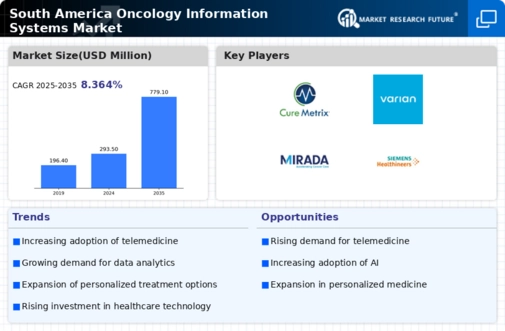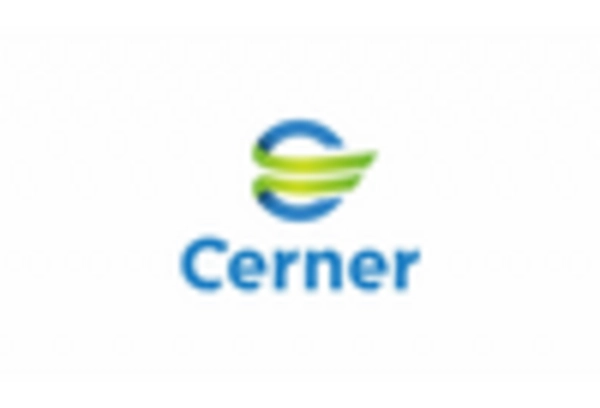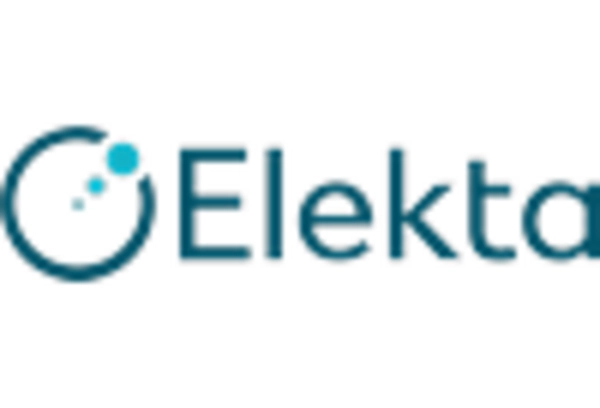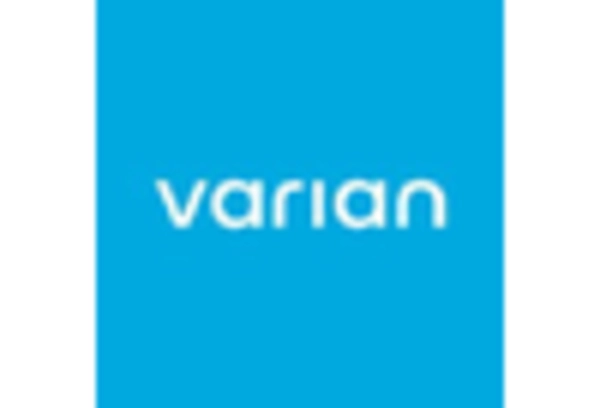Rising Cancer Incidence in South America
The oncology information-systems market in South America is growing due to the rising incidence of cancer. According to health statistics, cancer cases in the region have increased by approximately 20% over the past decade. This alarming trend necessitates the implementation of advanced oncology information systems to manage patient data, treatment plans, and outcomes effectively. As healthcare providers strive to enhance their capabilities in cancer care, the demand for sophisticated information systems is likely to rise. Furthermore, the increasing burden of cancer on healthcare systems compels governments and institutions to invest in technology that can streamline processes and improve patient management. Consequently, the oncology information-systems market is poised for expansion as stakeholders seek solutions to address the growing challenges posed by cancer treatment and management.
Technological Advancements in Healthcare
Technological advancements are significantly influencing the oncology information-systems market in South America. Innovations such as cloud computing, big data analytics, and telemedicine are transforming how healthcare providers deliver cancer care. The integration of these technologies into oncology information systems enhances data accessibility and improves decision-making processes. For instance, cloud-based solutions allow for real-time data sharing among healthcare professionals, which is crucial for collaborative treatment approaches. Moreover, the market is projected to grow at a CAGR of 15% over the next five years, driven by the increasing adoption of these technologies. As healthcare facilities upgrade their systems to incorporate these advancements, the oncology information-systems market is likely to witness substantial growth, reflecting the ongoing digital transformation in the healthcare sector.
Government Initiatives for Cancer Control
Government initiatives aimed at cancer control are playing a pivotal role in shaping the oncology information-systems market in South America. Various countries in the region have launched national cancer control programs that emphasize early detection, treatment, and research. These initiatives often include funding for healthcare infrastructure and technology, which directly benefits the oncology information-systems market. For example, Brazil's National Cancer Control Program has allocated over $100 million to enhance cancer care services, including the implementation of advanced information systems. Such government support not only boosts the market but also encourages private sector investment in oncology information technologies. As these initiatives continue to evolve, they are likely to create a more favorable environment for the growth of oncology information systems across South America.
Collaboration Between Public and Private Sectors
Collaboration between public and private sectors is emerging as a key driver for the oncology information-systems market in South America. Partnerships between government entities, healthcare providers, and technology companies are fostering the development of innovative solutions tailored to the region's unique healthcare challenges. These collaborations often result in shared resources, expertise, and funding, which can accelerate the implementation of advanced oncology information systems. For instance, joint ventures have been established to create integrated platforms that streamline patient management and enhance treatment delivery. As these partnerships continue to grow, they are likely to enhance the capabilities of oncology information systems, making them more effective in addressing the needs of cancer patients. This collaborative approach may also lead to increased investment in research and development, further propelling the market forward.
Increasing Demand for Data-Driven Decision Making
The oncology information-systems market in South America is witnessing an increasing demand for data-driven decision-making processes. Healthcare providers are recognizing the importance of utilizing data analytics to improve patient outcomes and optimize treatment protocols. The ability to analyze large volumes of patient data enables oncologists to make informed decisions regarding treatment plans and resource allocation. This trend is further supported by the growing emphasis on personalized medicine, which relies heavily on data analysis to tailor treatments to individual patients. As a result, the oncology information-systems market is likely to expand as healthcare organizations invest in systems that facilitate data collection and analysis. The shift towards evidence-based practices is expected to drive innovation and enhance the overall effectiveness of cancer care in the region.


















Leave a Comment